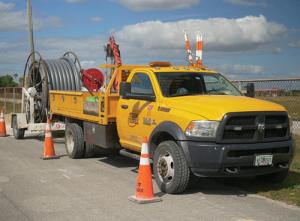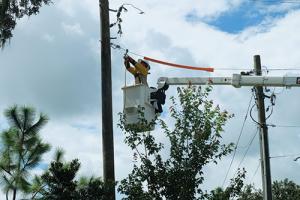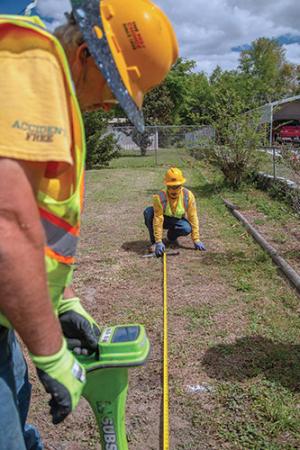TECO Energy
Dave Plusquellic is TECO Storm Protection Plan Program Lead at TECO Energy.
As we have experienced the effects of innovation in all aspects of our industry, so too has innovation revolutionized the conversion from "overheading" to undergrounding. Converting selected overhead wires to underground cables has consequently become a compelling option for utilities across the country. PUF discusses this topic with Dominion Energy's Les Carter, Florida Power & Light's Jerry Cook, Pepco's Jaclyn Cantler and Donna Cooper, Southern California Edison's Raj Roy, Thuan Tran and Angel Brito, and TECO Energy's Dave Plusquellic.

PUF's Steve Mitnick: How is your department structured to support the Storm Protection Plan?
Dave Plusquellic: The formation of the Storm Protection Plan team started in late 2019. Once we identified our goals and targets, we began building the internal team and defining the roles we needed to support those targets. The targets also allowed our contractor partners to build their teams to support the long-range goals of the program.
We started with a small start-up team with people in the roles we thought were critical for launch in 2020. We knew we would need to grow strategically throughout 2021 and 2022, and we needed time and experience to identify the most efficient structure.
In early 2021, we secured a dedicated warehouse with a full-time team. We're currently adding to our design and project management teams. Throughout late 2021 we'll be launching a full construction management team.
 Tampa Electric crews dropping overhead lines.
Tampa Electric crews dropping overhead lines.
PUF: What are your goals with this team?
Dave Plusquellic: The goal has always been to make sure we do our absolute best to invest money wisely and cost-effectively to the benefit of our customers. Specific to SPP, it's to ensure we're making sound investments that will result in more reliable service during extreme weather and to lower the overall time and costs associated with restoring power after those extreme weather events. We're fortunate to have this opportunity, and we're equally passionate about the responsibility that comes with it.
PUF: You have to be strategic and selective about what you're undergrounding. How did you narrow it down or determine what to prioritize?
Dave Plusquellic: Yes, you have to know what your goal is before you can start prioritizing and tackling the operational hurdle of standing up a program to bury lines. The question for us wasn't just, where do we see frequent outages?
 Tampa Electric crews measuring for undergrounding.
Tampa Electric crews measuring for undergrounding.
It was focused on where are we most likely to have expensive, prolonged, difficult-to-repair outages from extreme weather events �" those are the places we need to address, to provide our customers better reliability during a storm and to avoid lengthy delays and costly repairs after a storm.
The program required a comprehensive look at benefits versus costs, with a focus on extreme weather events, so we conducted a thorough and robust data-driven analysis.
PUF: Talk generally about the culture of Tampa Electric.
Dave Plusquellic: Tampa Electric's core value is safety �" of employees and customers. It is part of everything we do.
In addition, it is one of the most forward-looking companies I've been affiliated with. If you look at what we've done to our Big Bend plant, where we're modernizing it by converting it from coal to gas, if you look at our solar ambitions, we are the biggest solar generator in the state per customer.
We've also invested in projects like smart meters, or AMI, automated meters. We're doing a lot in these technical areas to advance the grid and technology. Putting that into context, the investments we're making in our system are impressive when you consider our size. We have eight hundred thousand customers and are smaller than many of our peers in the region.
The company has been supportive of the Storm Protection Plan, because once you have a certain part of the system hardened and undergrounded, it benefits all customers after extreme weather events, such as a hurricane.
PUF: How are customers reacting, and how's it going overall?
Dave Plusquellic: Overall, the customers like the idea of lines being underground, and most customers have been very positive. The biggest challenge we have is getting easements for the primary route and equipment.
We have a diverse service area. We've got some areas that are a bit more rural, and the lot sizes are bigger. Customers in these areas are generally more receptive to providing an easement.
When you go into a denser, more metropolitan area where the yards are smaller, the homes are closer together, and the area is more congested than the rural areas, it has been more challenging to obtain easements.
Our view is that the SPP is a customer experience program as much as it is a construction program. We have a small internal team dedicated to customer communications that is focused solely on how we provide the right information to our customers at the right time.
Our goal is to continually improve that process for the customer and to ensure each customer has the information they need to make the right decision about an easement on their property.
PUF: Where do you think this is going in three to five years?
Dave Plusquellic: We are about eighteen months into our Storm Protection Plan, and momentum and excitement are starting to build. We expect the project will grow to install about one hundred miles of underground lines every year. The SPP is part of our goal to create value for our customers, which we will achieve by increasing reliability and improving the customers' experience.
Lines Underground Innovations
Articles
- They're Innovating Undergrounding, by PUF's Steve Mitnick
- PG&E's Landmark RFI to Underground Ten Thousand Miles of Lines
Conversations



